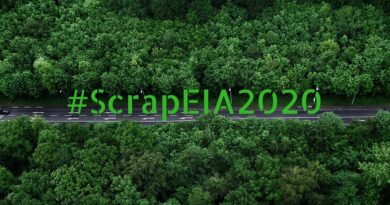All You Need to Know About EIA-2020
WHAT IS EIA?
An abbreviation that has been doing the rounds on various social platforms poses a question that needs to be addressed as many just do not know. The EIA (Environmental Impact Assessment) is an important regulation that prevents industrial and infrastructure projects from being approved or cleared without following the required safeguards. It looks at the potential impact that industry would have at the environment and then a panel of experts would either grant or deny the clearance.
HOW DID IT ALL BEGIN?
The Indian involvement with EIA began 20 years back. In the year 1976–77, the Planning commission had asked the Department of Science to look over the river-valley projects from an environmental angle. This was later expanded to cover the projects that required the approval of the Public Investment Board. Till 1994 environmental clearance was an administrative decision and lacked legislative support. Since then there have been 12 amendments made in the EIA notification of 1994.
The MoEF (Ministry of Environment, Forests and Climate Change) notified the new EIA legislation in September 2006. This notification makes it necessary for the industries, power plants, infrastructure, etc. to get environmental clearance. This new notification has put the responsibility of clearing projects on the state government based on the capacity of projects.

SO HOW IS IT DIFFERENT FROM THE PREVIOUS DRAFT?
BYPASSING EIA PROJECTS:
The draft exempts a long list of projects as outside the purview of the EIA, including any project the government deems to label as “strategic”. A strategic project has a primary goal of gaining a competitive advantage by focusing on the organization’s overall direction. In this case, strategic projects are those that, in the long run, improve the country’s economy. The draft says that no information on “such projects shall be placed in the public domain”.
COMPLIANCE REPORT ISSUE:
The 2006 amendment emphasized industries to submit their reports every 6 months but the EIA2020 draft says that industries can submit their reports only once a year. The concerned authority will not have the opportunity to question the promoters for not following the terms of clearance. The only remedy would be to impose a fine or punishment but that would not reverse the detrimental consequences on the environment.
POST-FACTO CLEARANCE:
The new draft of the Environment Impact Assessment allows for post-facto clearance and less public participation. This means that the consent for projects can be awarded even if they have started construction or have been running phase without securing environmental clearances. This also means that any environmental damage caused by the project is likely to be waived off as the violations get legitimized.
PUBLIC CONSULTATION PROCESS
The time allotted for public hearings has also been reduced to expedite the process. The draft notification provides for a reduction of the time period from 30 days to 20 days for the public to submit their responses during a public hearing for any application seeking environmental clearance. There is also a list of the selected projects in the new draft that have been proposed to be exempted from public participation. Modernization of irrigation projects, all building constructions, and area development projects, expansion or widening of national highways, all projects concerning national defense and security, are part of the list.
HOW DOES IT CONCERN YOU AND ME?
The new draft EIA Notification proposed by the Union government recently is a regressive departure from the 2006 EIA and would supersede it. The objective of the draft is to be environmentally friendly but instead, it is pro-industry and anti-people. This notification would cause a landmark shift in the way clearances are obtained in the country.
How does it affect:
· Industries and economic growth: Equipoise approach to sustainable development is provided by Environment Assessment Impact. It paves a faster way towards the economic growth of our country by letting new industries into the picture. It has a favorable impact in terms of creating job opportunities and India’s GDP.
· Local communities and ground workers: It is important to note that even though it is national legislation, it was only published in Hindi and English and not in any other vernacular languages. The Delhi High Court did order for translated copies of the draft in other scheduled languages which has not been done yet. This clearly excludes local communities from public participation as they can’t file objections against something if they cannot understand it.
· Environment: EIA identifies environmental risks, lessens conflicts by promoting community participation, reduces adverse environmental effects and provides a base for sustainable projects.
· Fundamental rights and the people: EIA is believed to take away the basic human rights mainly their right to information and have a direct effect on people who lead a bucolic life. On the advent of strategic projects, the bohemian Indians living in areas rich in terms of resources and biodiversity will be victims of this change.
Despite following the norms of EIA, India witnesses catastrophic effects on its biodiversity staking the environment. Gas leak at LG polymers in Vishakhapatnam on May 7 was operating without environmental clearance which led to a disaster like this affecting both the environment and innocent lives. A similar tragedy happened in Assam wherein the leakage of oil well caused fire leading to severe effects on rich biodiversity and livelihood of the area.Thereby the Draft EIA Notification dilutes the effectiveness of the process and shrinks its scope.
AVING THE WAY FORWARD:
On a positive note, the 2020 draft notification has a clause dedicated to definitions of several terms related to the EIA. It may be beneficial in the sense that it consolidates the EIA rules and has the potential of alleviating some ambiguity in the present law.
However various modifications must be taken into consideration while framing the draft for it to be more successful and beneficial.
In this context:
· Consultation of public opinions immaterial of the magnitude of the project with further emphasis on the protection and consideration of the interests of the local communities.
· Shifting the focus from minimizing the time for public consultation to ensuring adequate public access to information about the impact and consequences of the new draft. Further public awareness about the public hearing.
· Denial of Post-facto approvals and subsequent implementation of charges for those carrying out projects without any environmental clearance.
· Increasing the number of times for the compliance report to be submitted rather than restricting it to only one in a year.
· Mandatory implementation of prior- EC (Prior Environmental clearance) and prior- EP(Prior environment permission) and further validation of the same for a specified duration of time.
Several Independent environmental organizations and activists have been revolting against the new draft formulated by the Government such as Let India Breathe, Fridays for Future and There is no Earth B are a few of the several. One such group that has come to the limelight recently is Fridays For Future (FFF) India which is an autonomous, volunteer-driven, and a part of a global people’s movement for climate justice.
FFF and EIA 2020:
The autonomous people’s movement has been citing various concerns in the new draft of the EIA. The site has reportedly been brought down without prior notice along with those of Let India Breathe and There is no Earth B for launching digital campaigns and swerving people’s opinions on the new draft. FFF representatives state that they merely presented to spread the awareness by providing a sample email body containing necessary information that people could understand, read, and send on their own. This garnered a lot of public participation.
Further clarification on the action taken on the websites was cited as content that was “dangerous for the peace, tranquility, and sovereignty of India.” and also, inappropriate spamming of the Environment Minister, Prakash Javadekar’s personal email with “multiple emails with the subject name similar to “EIA 2020” with subsequent reporting of the same to the Cyber Crime authorities.
This was originally published by medium.com




